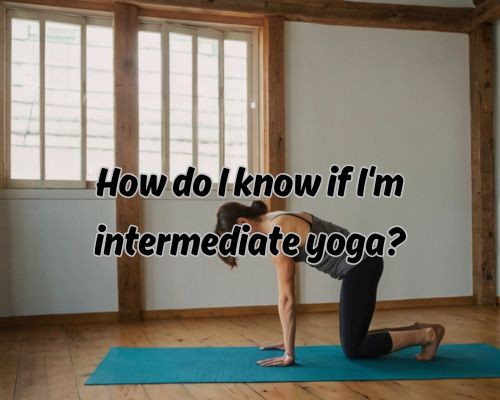Reaching the intermediate level in yoga signifies a progression in one’s practice. Here, the fundamentals have been mastered, and there’s readiness for more complex poses and techniques.
This stage typically involves a deeper focus on alignment, breath control, and mindfulness.

Practising yoga at an intermediate level also indicates that the practitioner is comfortable with a variety of poses and transitions. They are no longer overwhelmed by anatomical terms and can engage with multiple components of a pose simultaneously.
They are likely to have developed the strength, balance, and flexibility needed to tackle more challenging sequences and routines confidently. Furthermore, there’s a growing curiosity that goes beyond the mat as they explore various aspects of yoga philosophy and lifestyle.
This progression is not solely about the attainment of physical capabilities. It also encompasses a holistic approach to the practice, fostering a deeper connection between mind and body.
Individuals on this journey often find themselves motivated to dive into additional resources such as books or specialised workshops, see https://bikramyogamornington.com.au/, to support their growth. They seek to enhance both their physical and spiritual understanding of yoga.
Determining Your Yoga Level
Intermediate yoga practitioners can handle more complexity in their practice. They focus on alignment, combining poses with mindful breathing, and maintaining physical and mental awareness.
Progression from beginner to intermediate involves mastering basic poses and understanding the subtler aspects of yoga practice.
Understanding Yoga Proficiency
Yoga proficiency is not just about physical ability. It encompasses a robust understanding of both physical postures and mental discipline.
As practitioners reach the intermediate level, they develop a deeper awareness of their body’s alignment. This level involves combining multiple yoga poses smoothly while incorporating breath control and mindfulness.
At this stage, the practice becomes more introspective, focusing on refining poses and increasing body awareness. Intermediate yogis often tackle complex poses that require a harmonious blend of balance, flexibility, and strength.
Self-assessment Criteria for Intermediate Yogis
Determining if one has reached the intermediate level involves self-assessment of various skills. Important criteria include the ability to maintain breath awareness during challenging poses and to follow instructions that focus on alignment and detail.
Intermediate yogis often feel comfortable with poses like Downward-facing Dog, Warrior I and II. They can also engage in sequences without losing form or breath.
It’s about combining physical ability with steady mindfulness to embrace a more complete practice.
Progression from Beginner to Intermediate
The transition from a beginner to an intermediate level is marked by significant progress in understanding fundamental poses and integrating yoga into daily life.
Beginners often focus on basic postures and gaining flexibility. Meanwhile, intermediates refine these skills by increasing strength and precision.
During this progression, practitioners learn to hold poses longer, adding fluidity and control to their movements. The intermediate stage is also characterised by an improved ability to concentrate, manage breath, and function within a variety of yoga routines, see https://bikramyogamornington.com.au/, indicating a matured practice.
Exploring Intermediate Yoga Practices
Intermediate yoga practices serve as a bridge between foundational poses and more advanced techniques. These practices introduce greater complexity, enhancing flexibility, strength, and mindfulness.
Practitioners can expect to engage in sequences that build heat and encouraging personal growth through mindful engagement with each pose.
Key Aspects of Intermediate Classes
Intermediate yoga classes often incorporate a vinyasa flow, which focuses on synchronising movement with breath.
Classes may be labelled as Level 2, offering a more challenging pace and complex sequences.
Props like blocks and straps can be introduced to deepen poses and maintain alignment. There is an emphasis on building strength, fostering endurance, and enhancing balance skills through poses like navasana (boat pose) and dolphin pose.
Intermediate Poses and Sequences
Practitioners will encounter poses that demand more balance and strength.
Ardha Chandrasana (half moon pose) and Pincha Mayurasana (forearm stand) are typical intermediate poses, requiring core stability and wrist flexibility.
Classes may also include arm balances, encouraging improved focus and coordination.
Transitioning poses such as downward dog create an opportunity to engage the whole body, serving as both a transition and a resting pose.
Incorporating Props and Modifications
Incorporating props can assist in achieving proper alignment and prevent injury.
Blocks can lift the ground closer, making pincha mayurasana more accessible, while straps may assist in keeping shoulders and arms aligned in poses like downward dog.
Modifications cater to individual needs, allowing practitioners to explore the full expression of poses at their own pace.
Teachers often encourage exploring variations to suit different body types and flexibility levels.
Transitioning to Advanced Yoga
Transitioning to advanced yoga poses involves a refined focus. This includes breath, meditation, and mind-body connection.
Practitioners gain confidence in intermediate sequences. Then, they may attempt more complex poses. These poses require greater strength, flexibility, and balance.
Tools such as props and modifications remain relevant. They offer safety and deeper engagement with advanced poses.
The journey from intermediate to advanced practice is a gradual process. It is marked by steady progression and dedication.